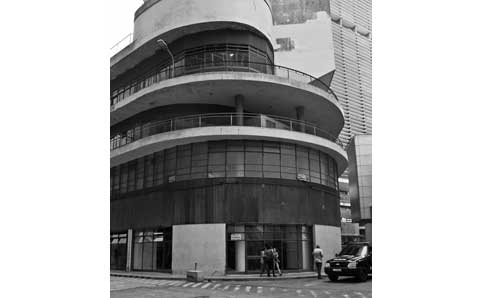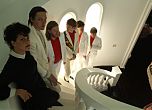
The opening of the Bienal on 7 September 2012 marked the start of a month in which São Paulo has gone art crazy, with a deluge of exhibitions, openings and events timed, for the most part, to coincide with the most important art event in Brazil’s art calendar.
But in amongst all the exhibitions and the parties, the seminars and the shows, one of the most interesting new spaces in the city has also picked September to launch itself upon SP’s cultural scene. Opening as a permanent space on 8 September 2012, Pivô looks set to become one of the finest places in town to get a dose of up-to-the-minute art and culture – and best of all, it’s set inside one of the most emblematic São Paulo buildings of all time: the magnificent Copan created by Oscar Niemeyer, whose curvaceous silhouette punctuates the cityscape like an immense, graceful gesture.
Inside Pivô, which takes the form of a three-storey, self-contained space at the end of the Copan, a sweeping gallery interspersed with columns forms the main exhibition hall in what’s intended to be an ‘experimental art space’, in the words of its founder, the young artist Fernanda Brenner. It’s a ‘pivot’, like its name, around which young artists and architects, art-lovers and curious minds are starting to rotate. And gallerists too: two of the city’s youngest, most successful galleries, Emma Thomas and Mendes Wood, are taking part in Pivô’s debut show, in the form of a group show by the latter and two solo shows from the former, of the works of Lucas Simões and Alexandre Brandão.
Making it happen
We took a tour of the building in late August and met the young team making it all happen. Builders and carpenters, artists and planners buzzed around the 3,500m space making preparations as the opening loomed. Curated by the art critic and architect Diego Matos, ‘Da próxima vez eu fazia tudo diferente’ (‘Next time, I’d have done it all differently’) is Pivô’s first show as a permanent space, although a one-off exhibition, ‘Imóvel’, was held there last year.
In a workspace on one of the building’s enormous verandas, busy embedding tiny treasures into glassy resin blocks, the artist Paloma Bosquê had just finished the immense task of sewing together metres and metres of sausage skin. Part of a multi-room installation that also includes resin blocks and a wax sculpture embedded into the building, the strange textile forms a gauzy, rustling sort of curtain. ‘It’s fine and delicate,’ says Bosquê, ‘but incredibly strong too. It needs to be, because just one tiny tear in your intestine could kill you’.
Bringing the building to life
Interaction with the fabric of the 1966 construction is a key theme – witness Lucas Simões’s maze, snaking through a hall that links one space to another in the labyrinthine building; or the meticulous pencil drawing by Nazareno Rodrigues that fills the walls of one walk-in cubicle. Or Vitor César’s doors installation, set against Eduardo Frota’s intervention, in which he has removed a set of window panes only to hang them again, a metre from the frames, on the veranda.
It’s fascinating to see the space, empty for 20 years before being rented to Brenner and her troupe, being awakened and set in motion. Why had it lain empty so long? ‘The sort of people who might rent a space like this – companies – are looking for offices with 45 parking spaces in purpose-built blocks in Berrini,’ says Brenner. ‘They don’t want a Frankenstein’s monster, a white elephant like this. It makes no sense to them without massive renovations. We’re survivors of the Centro’s wave of property speculation. This is an act of resistance.’



